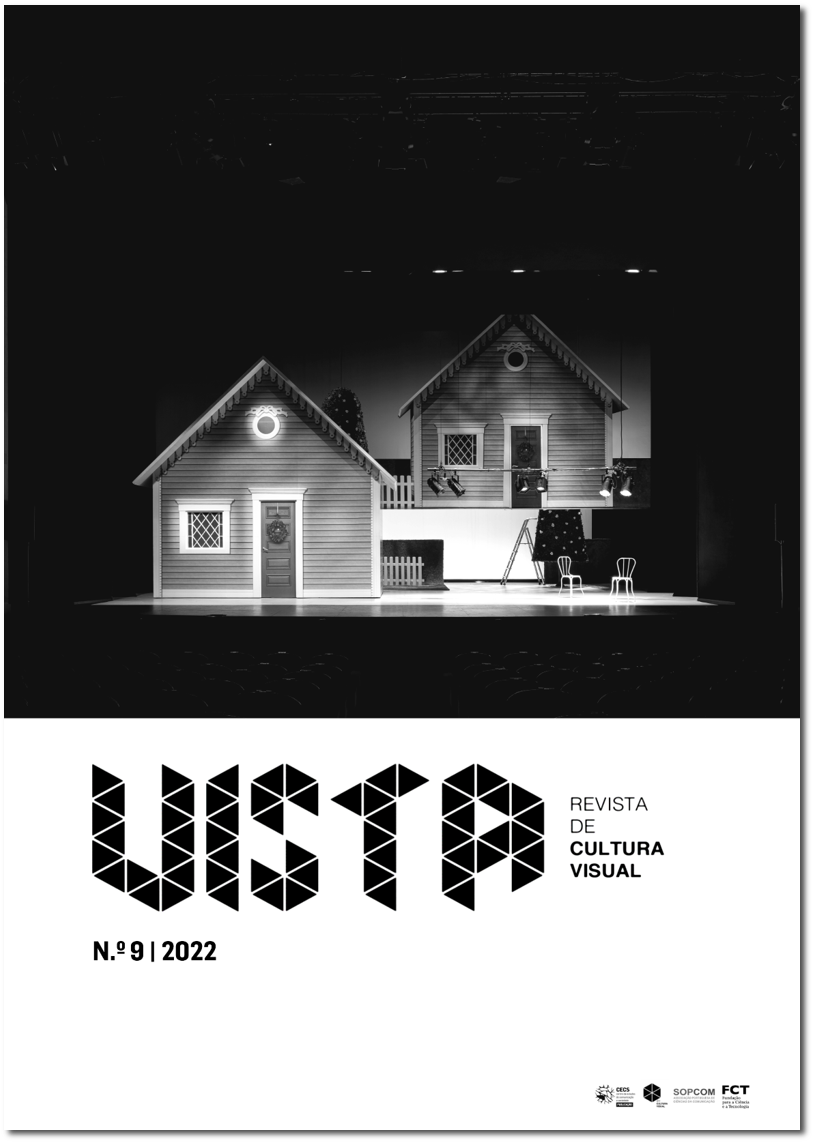Migration and Syrian Conflict: The Narrative Behind the Image
DOI:
https://doi.org/10.21814/vista.3650Keywords:
migration, Syria, war, policy, photographyAbstract
This article aims to reflect on migratory flows and the political role of the image using the war in Syria as a reference. Hamza Al-Ajweh's photograph titled "A Syrian child walks down a street past the rubble of destroyed buildings in the rebel-controlled city of Douma in the Eastern Ghouta enclave outside Damascus", taken on March 8, 2018, and published for the first time at the Los Angeles Times, will be used as a point of reference for the discussion and analysis proposed here. The complexity of displacements in this specific context of war leads us to design Syrian mobility after the beginning of the war in 2011, understanding that this complexity goes far beyond the formal definitions used by international agencies. For a closer understanding of the debate, we designed the discussion in three parts: a brief contextualization of the conflict in Syria, which began with the Arab Spring and continues until today. This socio-political contextualization serves here as a backdrop for discussing not only generic migratory categories but to help better understand people, movements and the demand for new categories and visual reflections that go beyond current perspectives. And in the last part, we will discuss how the image of the photographer Hamza Al-Ajweh helps us think about multiple political and transformative aspects of the picture.
Downloads
References
Afeganistão: O que é a sharia, lei islâmica que o talebã quer aplicar no país? (2021, 17 de agosto). BBC News. https://www.bbc.com/portuguese/internacional-58251684
Appadurai, A. (1998). Putting hierarchy in its place. Cultural Anthropology, 3(1), 36–49.https://doi.org/10.1525/can.1988.3.1.02a00040
Araújo, C. (2012, 16 de julho). Alauítas: A minoria síria que mata por temer ser aniquilada. Veja. http://veja.abril.com.br/noticia/mundo/alauitas-a-minoria-siria-que-mata-por-temer-ser-aniquilada
Azoulay, A. (2008). The civil contract of photography. MIT Press.
Azoulay, A. (2012). Civil imagination: A political ontology of photography. Verso.
Barthes, R. (1990). O óbvio e o obtuso: Ensaios sobre fotografia, cinema, teatro e música – Ensaio críticos III (L. Novaes, Trad.). Nova Fronteira. (Trabalho original publicado em 1982)
Bell, E., & Davison, J. (2013). Visual management studies: Empirical and theoretical approaches. International Journal of Management Reviews, 15(2), 167–184. https://doi.org/10.1111/j.1468-2370.2012.00342.x
Bleiker, R. (2012). Aesthetics and world politics. Palgrave Macmillan.
Bowen, J. (2012). The Arab uprisings: The people want the fall of the regime. Simon & Schuster UK.
Brummitt, W. (1973). Photography is... American Photographic Book Publishing.
Bulos, N. (2018, 8 de março). Thousands displaced, aid delivery halted as violence consumes Syrian enclave. Los Angeles Times. https://www.latimes.com/world/la-fg-syria-ghouta-20180308-story.html
Burgin, V. (1982). Looking at photographs. In V. Burgin (Ed.), Thinking photography (pp. 142–153). Macmillan.
CNN. (2013, 5 de fevereiro). Christian militia standing behind Assad [Vídeo]. YouTube. http://youtu.be/FQIrSR6tKJg
Cogo, D. (2001). Mídia, imigração e interculturalidade: Mapeando as estratégias de midiatização dos processos migratórios e das falas imigrantes no contexto brasileiro. Comunicação & Informação, 4(1/2), 11–32. https://doi.org/10.5216/c&i.v4i1/2.23453
Coulter, G. (2013). Gerhard Richter's use of photography to challenge our understanding of the real. International Journal of Arts and Commerce, 2(10), 83–92.
Dados, N. (2010). Liminal transformations: Folding the surface of the photograph. Conserveries Mémorielles, (7), 1–16.
Daher, J. (2019, 4 de setembro). The paradox of Syria's reconstruction. Carnegie Middle East Center. https://carnegie-mec.org/2019/09/04/paradox-of-syria-s-reconstruction-pub-79773
Falk, F. (2010). Invasion, infection, invisibility: An iconology of illegalized immigration. In C. Bischoff, F. Falk, & S. Kafehsy (Eds.), Images of illegalized immigration: Towards a critical iconology of politics (pp. 83–100). Transcript.
Fayyad, H. (2021, 10 de fevereiro). The Arab Spring: A social media revolution? [Vídeo]. Middle East Eye. https://www.middleeasteye.net/video/arab-spring-social-media-revolution
Fildis, A. T. (2012). Roots of Alawite-Sunni rivalry in Syria. Middle East Policy Council, 19(2), 148–156. https://doi.org/10.1111/j.1475-4967.2012.00541.x
Glass, C. (2017, 25 de outubro). The Syrian civil war is decided. Stratfor. https://worldview.stratfor.com/article/syrian-civil-war-decided
Grau, O., & Hinterwaldner, I. (Eds.). (2021). Retracing political dimensions: Strategies in contemporary new media art. De Gruyter.
Grossman, A., & O'Brien, A. (Eds.). (2007). Projecting migration: Transcultural documentary practice. Wallflower Press.
Ianchovichina, E., & Devarajan, S. (2021, 21–25 de junho). Why does the Arab Spring keep coming back? [Apresentação em conferência]. Annual Bank Conference on Development Economics 2021: Global Unrest. https://thedocs.worldbank.org/en/doc/8215471cb2c756b0908a67de4e0d9ca8-0050022021/original/Why-Does-the-Arab-Spring-Keep-Coming-Back.pdf
Interview with Syrian President Bashar al-Assad. (2011, 31 de janeiro). The Wall Street Journal. https://www.wsj.com/articles/SB10001424052748703833204576114712441122894
Jameson, F. (1992). The geopolitical aesthetic: Cinema and space in the world system. Indiana University Press.
Kafehsy, S. (2010). Images of victims in trafficking in women: The Euro campaign against trafficking in women in Switzerland. In C. Bischoff, F. Falk, & S. Kafehsy (Eds.), Images of illegalized immigration. Towards a critical iconology of politics (pp.71–81). Transcript.
Kaplan, R. D. (1993, fevereiro). Syria: Identity crisis. The Atlantic. https://www.theatlantic.com/magazine/archive/1993/02/syria-identity-crisis/303860/
Kimball, D., & Davenport, K. (2021). Timeline of Syrian chemical weapons activity, 2012-2021. Arms Control Association. https://www.armscontrol.org/factsheets/Timeline-of-Syrian-Chemical-Weapons-Activity
Köhn, S. (2016). Mediating mobility: Visual anthropology in the age of migration. Wallflower Press.
Langmann, S., & Pick, D. (2018). Photography as a social research method. Springer.
Maigret, E. (2010). Sociologia da comunicação e das mídias (M. Bagno, Trad.). Senac. (Trabalho original publicado em 2003)
Malkki, L. (1995). Purity and exile: Violence, memory and national cosmology among Hutu refugees in Tanzania. Chicago University Press.
Marks, L. U. (2008). Experience – Information – Image: A historiography of unfolding. Arab cinema as example. Cultural Studies Review, 14(1), 85–98. https://doi.org/10.5130/csr.v14i1.2100
Momani, B. (2014, 10–12 de abril). The Arab Spring is genuine revolution, but a bumpy and arduous road ahead [Comunicação]. The Institute for New Economic Thinking and the Centre for International Governance Innovation (CIGI) Annual Meeting, Toronto, Canadá. https://www.ineteconomics.org/uploads/papers/MOMANI_Bessma_-Arab-Spring-a-Genuine-Revolutionary-Movement.pdf
Ozkizilcik, O. (2021). War without end: Who will be king-maker in Syria in 2022? TRT World. https://www.trtworld.com/opinion/war-without-end-who-will-be-king-maker-in-syria-in-2022-53176
Santos, M., Petrus, R., & Loureiro, A. (Eds.). (2014). Recortes interdisciplinares sobre migrações e deslocamentos. Léo Christiano Editorial.
Seale, P. (1989). Asad of Syria: The struggle for the Middle East. University of California Press.
Seale, P. (2011). Os dilemas da dinastia de Al-Assad. Le Monde Diplomatique. https://diplomatique.org.br/os-dilemas-da-dinastia-de-al-assad/
Silva, J. C. J., Bógus, L. M. M., & Silva, S. A. G. J. (2017). Os fluxos migratórios mistos e os entraves à proteção aos refugiados. Revista Brasileira de Estudos de População, 34(1), 15–30. https://doi.org/10.20947/S0102-3098a0003
Slackman, M. (2011, 25 de março). Syrian troops open fire on protesters in several cities. The New York Times. https://www.nytimes.com/2011/03/26/world/middleeast/26syria.html
Slim, R. (2012, 24 de fevereiro). Unite Syria's opposition first. MEI@75. https://www.mei.edu/publications/unite-syrias-opposition-first
Soszynski, M. (2006). How do pictures represent? Philosophy Now, (57), 20–21.
Spencer, S. (2011). Visual research methods in the social sciences: Awakening visions. Routledge.
Syrian Arab Republic. (2021). 2021 Needs and response summary. https://reliefweb.int/sites/reliefweb.int/files/resources/som_summary_2021.pdf
Valenta, M., Jakobsen, J., Župarić-Iljić, D., & Halilovich, H. (2020). Syrian refugee migration: Transitions in migrant statuses and future scenarios of Syrian mobility. Refugee Survey Quarterly, 39(2), 153–176. https://doi.org/10.1093/rsq/hdaa002
van Dijk, T. (1999). Discourse and racism. Discourse and Society, 10(2), 147–148. https://doi.org/10.1177/0957926599010002001
Warren, S. (2005). Photography and voice in critical qualitative management research. Accounting, Auditing & Accountability Journal, 18(6), 861–882. https://doi.org/10.1108/09513570510627748
Wood, G. (2017). A guerra do fim dos tempos (L. T. Motta, Trad.). Companhia das Letras. (Trabalho original publicado em 2016)
Wright, T. (2002). Moving images: The media representation of refugees'. Visual Studies, 17(1), 53–66. https://doi.org/10.1080/1472586022000005053
Wright, T. (2016). Press photography and visual rhetoric. In E. Margolis & L. Pauwels (Eds.), The Sage handbook of visual research methods (pp. 317–336). Sage.
Downloads
Published
How to Cite
Issue
Section
License
Copyright (c) 2022 Suzana Ramos Coutinho, Jesner Esequiel Santos

This work is licensed under a Creative Commons Attribution 4.0 International License.
Authors own the copyright, providing the journal with the right of first publication. The work is licensed under a Creative Commons Attribution 4.0 International License.













